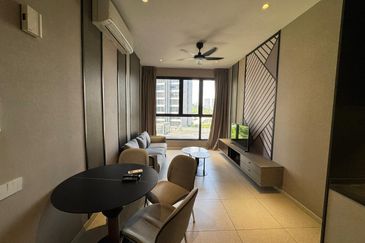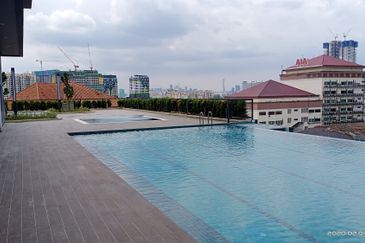
“WE are composers of solid symphonies … solid because of the buildings.” That is how Tan Sri Chan Sau Lai relates architecture to those who practise it.
The executive chairman of Beneton Properties Group is the founder of the PAM-Tan Sri Chan Sau Lai Architecture Award. PAM is the acronym of the Malaysian Institute of Architects. Chan is an architect by profession and sits on PAM Education Fund's Board of management and board of trustees.
It recognises outstanding achievements in design by architectural graduates and gives them a head start in the profession and industry. The award, which lays the foundation for training, internship, recognition and exposure, is not only timely but also essential in building a new generation of home-grown architects, says Chan.
Open to all Malaysian PAM student members based locally and abroad who have completed their Part II architecture degrees in the immediate preceding year, the award requires submissions to be sent electronically.
Chan, an experienced architect and property developer, appreciates aspiring architects who employ non-idealistic design concepts and are somewhat “wacky and whimsical” in their project briefs.
He believes architects who possess this trait ultimately aim to inspire the masses with their designs, and that this is what architecture and designing is all about. However, the only time they can toy with this kind of designing ideas is during their college and university days, he says.
“This is the only time they have the liberty to explore and expand their ideas, and do not have to worry about cost or how practical a project is. They can let their hair down and design a project without worrying about the external factors that fully fledged architects have to consider,” Chan says.
He believes the less a student’s idea conforms to the norm, the better an architect he or she will become in the future. Thus, he thought of the award four years ago to encourage students to be as creative as they can possibly be.
Another reason Chan encourages young and aspiring architects to be wacky and whimsical is to keep their minds agile as it requires one to constantly think out of the box — this will come in handy for them in the future and also benefit the architecture and design industry.
Judging the entries
Echoing Chan’s view is the judging panel for this year’s competition, comprising industry veterans and practitioners. Apart from Chan, the judges are PAM immediate past president Chan Seong Aun, award co-founder Boon Che Wee and current PAM president Mohd Zulhemlee An, along with two new panellists from PAM, Lim Pay Chye and Prof Osman Mohd Tahir.
Seong Aun feels that the quality of entries has remained the same over the past four years because all entries are electronically submitted. He believes newly minted architects are often constrained by the latest designing software and technology that are available to them.
“More often than not, I notice that the newbies get into a rut, much like a writer’s block, when they do their designing on a computer. Seeing their struggle, I usually tell them to do it old school — use pencil, paper and eraser. I know it’s clichéd but the old methods are still useable and sometimes they are better ways to see the design as a whole, even with all this technology,” says Seong Aun.
He opines that the students will be able to see the design in a whole new perspective and even improve their ideas when they are put on paper.


![Chan: This is the only time [the students will] have the liberty to explore and expand their ideas, and not have to worry about cost or how practical a project is. PAM](https://dbv47yu57n5vf.cloudfront.net/s3fs-public/editorial/my/2015/August/27/28/MccD_4t5_d007.jpg)
These established industry players have strong opinions about architecture and its future in Malaysia. They consider architecture and design as mediums of communication that happen through visuals — visually first on paper and later, when the building is completed and tangible.
Most people think of a building’s façade first but the major part of designing is actually in the interior where considerations have to be given to the type of materials used, ensuring the sustainability of the building and, of course, its interior design. As Chan points out, “Figuratively speaking, architects are jack of all trades and master of none,” to which the other veteran architects nod in agreement.
Commenting on the surge in the number of entries this year, Boon says it is probably because PAM went the extra mile to promote the competition to the heads of departments (HODs) in colleges and universities that offer architectural courses.
“We didn’t approach the HODs to make them force the students to participate, but rather, we wanted to let them know about the existence of the competition. We would much rather the students themselves take the initiative to participate in the competition. We believe initiative will bring about quality because the desire to win will be genuine and they will put their heart and soul into the project,” says Boon.
He adds that one of the reasons he and Chan started the competition in the first place was to boost the confidence and self-esteem of architectural students to prepare them for the hard, challenging, and at times, frustrating career ahead.
Speaking from experience, Boon says it takes a long time for an architect to be recognised and considered established. Hence, it can be a trying journey and that is when an architect’s confidence and self-esteem come into play.
“This is why once the finalists [of the competition] are shortlisted, they will have to face the panel of judges and present their brief in detail to us,” says Chan. “They should be able to tell the panel why they chose that particular area, the materials they used, what was the motive of the project, how the project would benefit the surrounding inhabitants and the environment in general. And if there is a problem in that said area, how their project will be able to solve the problem. Of course, they will also have to explain their design concept and everything that goes along with it.”
In a bid to reach all Malaysian architectural students around the world, PAM encourages them to become members as soon as they enrol in an architectural course. As members, students are kept abreast of the current issues related to the industry and notified of competitions such as this.
The panel feels that the best way to level the playing field in the competition is to open it to all Malaysian architectural students regardless of their geographical location. This is the reason why all project briefs are submitted electronically.
In the past three years, the winning briefs have come from Malaysians studying abroad. This year, the panel hopes to see a student from a local university take first place.
Environmentally and culturally sensitive
Zulhemlee observes that there is a slight change of trend seen in this year’s entries. He finds it interesting that a number of entries are centred on culture and take into consideration the inhabitants of the area as well as specific issues of the chosen area of development.
“Most of the briefs are low-key projects, but they are environmentally and culturally sensitive,” he says. “This goes to show that the students who come up with the brief not only understand and are familiar with the area and its surroundings but also have a deep desire to solve the problems that the area is facing or will eventually face. It is clear that these students have done in-depth research on the area and decided very carefully on suitable materials and are able to come up with a practical and useable solution for the problems.”
He adds, “In the future, this is what I want to see more of. It is easy for the panel to see where the design is coming from because it is detailed intricately in the submission. We are able to recognise the area because of the decorative elements. These are the things that we look for in the submissions. We too want to be inspired and it is refreshing to be inspired by the newer generation’s ideas and concepts.”
Lim says among the things that stand out for him are the mature and exciting designs and proposals the students have put forward. While he may be new to the judging panel, he had the opportunity to view entries from past years and he is sure that the designs in this year’s entries are more mature.




“More than that, I am happy to note that some of the entries use environmentally friendly solutions to enhance their ideas. This is very important because as builders, we want to create structures that are sustainable while protecting the environment for the future. It is a relief to see that students nowadays know how important sustainability and going green is because they will then apply it in their future designs. I have to say that makes me feel hopeful about the future of architecture in Malaysia,” Lim smiles.
He says the improvements are most probably due to the change and growth in the thought process of the students and is assured that it can only get better from here.
The quiet and poised Osman is also new to the panel. He says it is inspirational to see some of the projects showing integration between the design and cultural surroundings. He feels that the concept of involving culture in the design process can be taken globally, which will give these aspiring students more career opportunities and enhance their exposure.
“Among the shortlisted candidates this year, there are a few who pay close attention to the ‘spirit of the place’. When you fully immerse yourself in understanding what the place is about, its history and mingle with the people who live there, it will show in your brief. This is what ensures your project outshines the rest. And I am delighted to see so much passion and soul in some of the entries this year.”
The professor, however, notes that most candidates did not put much thought into incorporating any kind of landscape in their briefs. To him, planting trees in the empty spaces of a project just doesn’t cut it. He would like to see future candidates take landscaping a bit more seriously and detail it with care in their projects.
Sitting in with the panel is previous PAM president and past competition panellist Saifuddin Ahmad and this year’s award convener Amzar Ahmad.
Saifuddin says the award has established a reputation for itself in a number of local universities.
“As an academic adviser to some of the local universities in the field of architecture, I was privileged enough to be present at a recent presentation where the HODs of the architectural faculty proudly conveyed to new students that some of their seniors were shortlisted candidates of this competition in the previous years. Hence, the competition has become somewhat of a benchmark for excellence for the new students and, of course, they are encouraged to participate in the competition. It’s safe to say that the award has set a precedent. This is encouraging for us at PAM.”
Saifuddin adds that as a previous judge, the award has given him an idea of what to expect of the future generation of architects. Judging their submissions and watching the shortlisted candidates present their project briefs was an eye-opener for him.
Amzar, meanwhile, has a different opinion about how the competition has evolved. He feels that it saw the best set of entries in 2012, which was the first year it was held.
“Personally for me, in terms of standard, the quality of work has not changed. The ideas, yes, there is a vast improvement there, but standard and quality-wise, nothing really wowed me. In my opinion, it has been the same across the board throughout the years after 2012.”
Thinking out of the box
The panel, together with the convener and invited guests, agree that for students to come up with a detailed and well-presented brief, a major contributing factor would be an education that allows them to explore all avenues that are available to them.
When students are given the freedom to explore and experiment, the exposure and lessons learnt are invaluable. More than that, it builds a thought process that will give them the maturity needed to succeed in the field, say the panellists.
They judge not only the quality of the work but also the personality of the shortlisted candidates and at times, felt discouraged by the lack of thought and creativity shown.
The judges say submissions from students studying overseas appear superior to those from local students. It is their belief that if the local academic curriculum does not change to include and emphasise the importance of critical thinking, the students would not only lose out to their counterparts overseas but also be less equipped to sustain themselves in the field of architecture. This, the panel feels, could severely lessen their opportunities in getting clients in the future.
As the panellists note, architecture and design cannot be rushed but the long and arduous process is bearable if there is a burning passion to build something meaningful for the betterment of the society.
“Because, remember that as builders, what we design and build affects people differently in different ways,” Chan concludes.
This article first appeared in property, a section of the digitaledge WEEKLY, on Aug 31, 2015. Subscribe here.
TOP PICKS BY EDGEPROP

Millerz Square
Jalan Klang Lama (Old Klang Road), Kuala Lumpur

Sfera Residency @ Puchong South
Puchong, Selangor

Bandar Mahkota Banting (Brooklands)
Banting, Selangor

Alam Perdana Industrial Park
Puchong, Selangor

The Sky Residence @ Shamelin
Cheras, Kuala Lumpur




















